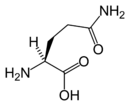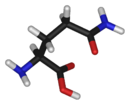Difference between revisions of "Glutamine" - New World Encyclopedia
Rick Swarts (talk | contribs) |
Rick Swarts (talk | contribs) |
||
| Line 11: | Line 11: | ||
}} | }} | ||
| − | '''Glutamine''' | + | '''Glutamine''' is an α-[[amino acid]] that is found in many [[protein]]s and is a neutralized version of the acidic amino acid [[glutamic acid]], having an [[amide]] side chain that is formed by replacing a side-chain [[hydroxyl]] of glutamic acid with an [[amine]] functional group. Glutamine is the most abundant amino acid in [[human being]]s (Longe 2005). It is important in many [[metabolism|metabolic]] processes, in the elimination of toxic ammonia from the body, and in [[immune system|immunity]], as well as a nutritional supplement in treating a variety of [[disease]]s. |
| + | The L-isomer, which is the only form that is involved in protein synthesis, is one of the 20 [[amino acid#standard amino acid|standard amino acids]] common in animal proteins and required for normal functioning in humans. However, it is not considered to be an [[amino acid#essential amino acid|"essential" amino acid]] since it does not have to be taken in with the diet, but can be synthesized by the human body from other compounds through chemical reactions. It is essential in the diet of premature infants, however, who cannot produce glutamine fast enough. | ||
| − | + | STRESS | |
| − | + | Glutamine's three letter code is Gln, its one letter code is Q, and its systematic name is 2-Amino-4-carbamoylbutanoic acid(IUPAC-IUB 1983). A three-letter designation for either glutamine (Gln) or glutamic acid (Glu) is '''Glx'''—this is often used in cases in which peptide sequencing reactions may convert glutamine to glutamate (or vice versa), leaving the original identity of the amino acid in doubt. | |
| − | |||
| − | |||
| − | |||
| − | |||
| − | |||
| − | |||
==Structure== | ==Structure== | ||
| Line 39: | Line 34: | ||
| − | + | H2N-CO-[CH2]2-CH(NH2)-COOH | |
Revision as of 00:37, 27 June 2007
  Chemical structure of L-glutamine | |
Glutamine | |
| Systematic (IUPAC) name | |
| (2S)-2-amino-4-carbamoyl-butanoic acid | |
| Identifiers | |
| CAS number | 56-85-9 |
| PubChem | 738 |
| Chemical data | |
| Formula | C5H10N2O3 |
| Mol. weight | 146.15 |
| SMILES | N[C@@H](CCC(N)=O)C(O)=O |
| Complete data | |
Glutamine is an α-amino acid that is found in many proteins and is a neutralized version of the acidic amino acid glutamic acid, having an amide side chain that is formed by replacing a side-chain hydroxyl of glutamic acid with an amine functional group. Glutamine is the most abundant amino acid in human beings (Longe 2005). It is important in many metabolic processes, in the elimination of toxic ammonia from the body, and in immunity, as well as a nutritional supplement in treating a variety of diseases.
The L-isomer, which is the only form that is involved in protein synthesis, is one of the 20 standard amino acids common in animal proteins and required for normal functioning in humans. However, it is not considered to be an "essential" amino acid since it does not have to be taken in with the diet, but can be synthesized by the human body from other compounds through chemical reactions. It is essential in the diet of premature infants, however, who cannot produce glutamine fast enough.
STRESS
Glutamine's three letter code is Gln, its one letter code is Q, and its systematic name is 2-Amino-4-carbamoylbutanoic acid(IUPAC-IUB 1983). A three-letter designation for either glutamine (Gln) or glutamic acid (Glu) is Glx—this is often used in cases in which peptide sequencing reactions may convert glutamine to glutamate (or vice versa), leaving the original identity of the amino acid in doubt.
Structure
In biochemistry, the term amino acid is frequently used to refer specifically to alpha amino acids: those amino acids in which the amino and carboxylate groups are attached to the same carbon, the so-called α–carbon (alpha carbon). The general structure of these alpha amino acids is:
R
|
H2N-C-COOH
|
H
where R represents a side chain specific to each amino acid.
Most amino acids occur in two possible optical isomers, called D and L. The L amino acids represent the vast majority of amino acids found in proteins. They are called proteinogenic amino acids. As the name "proteinogenic" (literally, protein building) suggests, these amino acid are encoded by the standard genetic code and participate in the process of protein synthesis. In glutamic acid, only the L-stereoisomer is involved in protein synthesis in mammals.
Glutamic acids chemical formula is HOOC-CH(NH2)-(CH2)2-COOH (very similar to aspartic acid's formula, HOOC-CH(NH2)-CH2-COOH), but with an extra CH2), or more generally C5H9NO4. (Aspartic acid's general forumula is C4H7NO4.)
H2N-CO-[CH2]2-CH(NH2)-COOH
Biochemistry
Formation and Nomenclature
Glutamine is genetically coded for by the RNA codons CAA and CAG. Glutamine's three-letter abbreviation is Gln, and its one-letter abbreviation is Q. A three-letter designation for either glutamine or glutamic acid is Glx (one-letter abbreviation: Z).
Like other amino acids, glutamine is biochemically important as a constituent of proteins. Glutamine is also crucial in nitrogen metabolism. Ammonia (formed by nitrogen fixation) is assimilated into organic compounds by converting glutamic acid to glutamine. The enzyme that accomplishes this is called glutamine synthetase. Glutamine can, hence, be used as a nitrogen donor in the biosynthesis of many compounds, including other amino acids, purines, and pyrimidines.
Artificial glutamine synthesis was first reported in 1933 in the Bergmann-Zervas carbobenzoxy method [1]
Nutrition
Occurrences in Nature
Glutamine is found in foods high in proteins, such as fish, red meat, beans, and dairy products.
Use
Glutamine is a supplement that is used in weightlifting, bodybuilding, endurance and other sports, as well as by those who suffer from muscular cramps or pain—particularly elderly people. The main use of glutamine within the diet of either group is as a means of replenishing the body's supply of amino acids that have been used during exercise or everyday activities.
Studies which are looking into problems with excessive consumption of glutamine thus far have proved inconclusive. Normal supplementation is healthy mainly because glutamine is helpful after prolonged periods of exercise (for example, a workout or exercise in which amino acids are required for use) and replenishes amino acid supply; this being the main reason glutamine is recommended during fasting or for people who suffer from physical trauma, immune deficiencies, or cancer.[2] A secondary benefit to bettering body immunity is fortification of the intestinal tract, responsible for roughly 70% of the body's immunity.
Aiding gastrointestinal function
There have been several recent studies into the effects of glutamine and what properties it possesses, and, there is now a significant body of evidence that links glutamine-enriched diets with intestinal effects; aiding maintenance of gut barrier function, intestinal cell proliferation and differentiation, as well as generally reducing septic morbidity and the symptoms of Irritable Bowel Syndrome. The reason for such "cleansing" properties is thought to stem from the fact that the intestinal extraction rate of glutamine is higher than that for other amino acids, and is therefore thought to be the most viable option when attempting to alleviate conditions relating to the gastrointestinal tract. Template:Ref N
These conditions were discovered after comparing plasma concentration within the gut between glutamine-enriched and non glutamine-enriched diets. However, even though glutamine is thought to have "cleansing" properties and effects, it is unknown to what extent glutamine has clinical benefits, due to the varied concentrations of glutamine in varieties of food. Template:Ref N
Aiding recovery after surgery
It is also known that glutamine has various effects in reducing healing time after operations. Hospital waiting times after abdominal surgery are reduced by providing parenteral nutrition regimens containing amounts of glutamine to patients. Clinical trials have revealed that patients on supplementation regimens containing glutamine have improved nitrogen balances, generation of cysteinyl-leukotrienes from polymorphonuclear neutrophil granulocytes and improved lymphocyte recovery and intestinal permeability (in postoperative patients) - in comparison to those who had no glutamine within their dietary regime; all without any side-effects. Template:Ref N
See also
- Bodybuilding supplements
- Dietitian
ReferencesISBN links support NWE through referral fees
- ↑ Bergmann, M., Zervas, L., and Salzmann, L., Ber. them. Ges., 99, 1233 (1933).
- ↑ Glutamine used for the Immune System and Cancer. Retrieved 2006-07-28.
- Template:Note N Template:Note N File:Free text.png Boza J.J., Dangin M., Moennoz D., Montigon F., Vuichoud J., Jarret A., Pouteau E., Gremaud G., Oguey-Araymon S., Courtois D., Woupeyi A., Finot P.A. and Ballevre O. Free and protein-bound glutamine have identical splanchnic extraction in healthy human volunteers. Am J Physiol Gastrointest Liver Physiol. 2001 Jul; 281(1): G267-74. PMID 11408280 Free text
- Template:Note N McAnena O.J., Moore F.A., Moore E.E., Jones T.N. and Parsons P. Selective uptake of glutamine in the gastrointestinal tract: confirmation in a human study. Br J Surg. 1991 Apr; 78(4): 480-2. PMID 1903318
- Template:Note N Morlion B.J., Stehle P., Wachtler P., Siedhoff H.P., Koller M., Konig W., Furst P., Puchstein C. Total parenteral nutrition with glutamine dipeptide after major abdominal surgery. Ann Surg. 1998 Feb; 227(2): 302-8. PMID 9488531
- Template:Note N Jiang Z.M., Cao J.D., Zhu X.G., Zhao W.X., Yu J.C., Ma E.L., Wang X.R., Zhu M.W., Shu H., Liu Y.W. The impact of alanyl-glutamine on clinical safety, nitrogen balance, intestinal permeability, and clinical outcome in postoperative patients: a randomised, double-blind, controlled study of 120 patients. JPEN J Parenter Enteral Nutr. 1999 Sep-Oct;23(5 Suppl):S62-6. PMID 10483898
- International Union of Pure and Applied Chemistry and International Union of Biochemistry and Molecular Biology (IUPAC-IUB) Joint Commission on Biochemical Nomenclature. 1983. Nomenclature and symbolism for amino acids and peptides: Recommendations on organic & biochemical nomenclature, symbols & terminology. IUPAC-IUB. Retrieved June 14, 2007.
- Lehninger, A. L., D. L. Nelson, and M. M. Cox. 2000. Lehninger Principles of Biochemistry, 3rd ed. New York: Worth Publishing. ISBN 1572591536.
- Longe, J. L. 2005. The Gale Encyclopedia of Alternative Medicine. Detroit: Thomson Gale. ISBN 0787674249.
External links
Template:ChemicalSources
| Major families of biochemicals | ||
| Peptides | Amino acids | Nucleic acids | Carbohydrates | Nucleotide sugars | Lipids | Terpenes | Carotenoids | Tetrapyrroles | Enzyme cofactors | Steroids | Flavonoids | Alkaloids | Polyketides | Glycosides | ||
| Analogues of nucleic acids: | The 20 Common Amino Acids | Analogues of nucleic acids: |
| Alanine (dp) | Arginine (dp) | Asparagine (dp) | Aspartic acid (dp) | Cysteine (dp) | Glutamic acid (dp) | Glutamine (dp) | Glycine (dp) | Histidine (dp) | Isoleucine (dp) | Leucine (dp) | Lysine (dp) | Methionine (dp) | Phenylalanine (dp) | Proline (dp) | Serine (dp) | Threonine (dp) | Tryptophan (dp) | Tyrosine (dp) | Valine (dp) | ||
| ||||||||||||||
Credits
New World Encyclopedia writers and editors rewrote and completed the Wikipedia article in accordance with New World Encyclopedia standards. This article abides by terms of the Creative Commons CC-by-sa 3.0 License (CC-by-sa), which may be used and disseminated with proper attribution. Credit is due under the terms of this license that can reference both the New World Encyclopedia contributors and the selfless volunteer contributors of the Wikimedia Foundation. To cite this article click here for a list of acceptable citing formats.The history of earlier contributions by wikipedians is accessible to researchers here:
The history of this article since it was imported to New World Encyclopedia:
Note: Some restrictions may apply to use of individual images which are separately licensed.